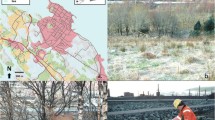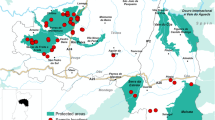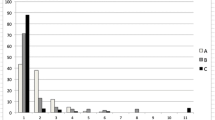Abstract
The narrow Andean-Patagonian temperate rainforest strip in the west of southern South America is inhabited by two endemic species of cervids, the southern pudu (Pudu puda) and the huemul (Hippocamelus bisulcus), both cataloged as near threatened and threatened species, respectively. One of the possible causes of their declined number is the susceptibility to livestock diseases. Significant zooarchaeological records of both deer have been found throughout the Holocene from Patagonia. The present contribution reports the first paleoparasitological results obtained from coprolites of endemic deer from the archeological site “Cueva Parque Diana,” Neuquén Province, Argentina, and discusses the possible diseases found in ancient times. Thirty-four coprolites were fully processed, rehydrated, homogenized, sieved, subjected to spontaneous sedimentation, and examined by light microscopy. Thirty samples contained parasite remains. The presence of diverse parasitic diseases such as trematodioses, metastrongylosis, trichuriosis, strongylida gastroenteritis, dioctophymosis, and coccidiosis which could cause diseases in deer previous to the arrival of European livestock and the presence of zoonotic diseases in the hunters-gatherers and fishermen are discussed.















Similar content being viewed by others
References
Acha PN, Szyfres B (2003) Zoonoses and communicable diseases common to man and animals, vol III, 3rd edn. Parasitoses, Pan American Health Organization, USA
Anderson RC (2000) Nematode parasites of vertebrates. Their development and transmission. CAB International, Wallingford Oxon
Araújo A, Reinhard K, Ferreira LF, Pucu E, Chieffi PP (2013) Paleoparasitology: the origin of human parasites. Arq Neuropsiquiatr 71:722–726
Beltrame MO, Tietze E, Pérez AE, Sardella NH (2017) First paleoparasitological record of digenean eggs from a native deer. Vet Parasitol 235:83–85 from Patagonia Argentina (Cueva Parque Diana archaeological site)
Black-Decima PA, Corti P, Díaz N, Fernandez R, Geist V, Gill R, Gizejewski Z, Jiménez J, Pastore H, Saucedo C, Wittmer H (2016) Hippocamelus bisulcus. The IUCN Red List of Threatened Species 2016: e.T10054A22158895. Downloaded on 27 October 2016
Bravo Antilef MJ (2013) Probables causas de muerte y principales hallazgos en la necropsia de pudúes (Pudu puda) examinados durante 20 años en el sur de Chile. Memoria de Título. Universidad Austral de Chile. Facultad de Ciencias Veterinarias. Instituto de Patología Animal
Callen EO, Cameron TWM (1960) A prehistoric diet revealed in coprolites. New Sci 8:35–40
Calvopiña M, Caballero H, Morita T, Korenaga M (2016) Case report: human pulmonary infection by the zoonotic Metastrongylus salmi nematode. The first reported case in the Americas. AmJTrop Med Hyg 95:871–873
Chame M (2003) Terrestrial mammal feces: a morphometric summary and description. Mem Inst Oswaldo Cruz 98:71–94
Chapman HD, Barta JR, Blake D, Gruber A, Jenkins M, Smith NC, Suo X, Tomley FM (2013) Chapter 2: a selective review of advances in coccidiosis research. Adv Parasitol 83:93–171
Chauhan S, Kaval S, Tewari S (2016) Dioctophymiasis: a rare case report. J Clin Diag Res 10(2):DD01–DD02
Cortés M (2006) Identificación de formas reproductivas de parásitos gastrointestinales, en mamíferos nativos presentes en el Buin Zoo, Chile. Memoria de título. Escuela de Medicina Veterinaria, Universidad de Concepción, Chillán
Díaz NI, Smith-Fluek JA (2000) El huemul patagónico: un misterioso cérvido al borde de la extinción. L.O.L.A, Argentina, p 156
Duval S, Sievers G, Valverde M (1990) Contribución al diagnóstico de los parásitos del pudú. VIII Congreso Nacional de Medicina Veterinaria. Valdivia, Chile
Fernández PM, Cruz I, Belardi JB, De Nigris M, Muñoz AS (2015) Human predation and natural history of huemul (Cervidae; Hippocamelus bisulcus Molina) in Patagonia: a zooarchaeological analysis. J Ethnobiol 35:472–498
Ferreira LF, Araújo A, Confalonieri U (1988) Paleoparasitologia no Brasil. PEC/ENSP/FIOCRUZ, Rio de Janeiro, p 158
Ferreira LF, Araújo A, Confalonieri U, Chame M, Ribeiro B (1992) Eimeria oocysts in deer coprolites dated from 9000 years B.P. Mem Inst Oswaldo Cruz 87:105–106
Gassó F, Rossi L, Mentaberre G, Casas E, Velarde R, Nosal P, Serrano E, Segales J, Fernandez-Llario P, Feliu C (2014) An identification key for the five most common species of Metastrongylus. Parasitol Res 113:3495–3500
Jolley WR, Bardsley KD (2006) Ruminant Coccidiosis. Vet Clin Food Anim 22:613–621
Jouy-Avantin F (2003) A standardized method for the description and the study of coprolites. J Archaeol Sci 30:367–372
Lutz A (1919) O Schistosomum mansoni e a schistosomatose segundo observações feitas no Brasil. Mem Inst Oswaldo Cruz 11:121–155
Marruchella G, Paoletti B, Speranza R, Di Guardo G (2012) Fatal bronchopneumonia in a Metastrongylus elongatus and porcine circovirus type 2 co-infected pig. Res Vet Sci 93:310–312
Meier D, Merino ML (2007) Distribution and habitat features of southern pudu (Pudu puda Molina, 1782) in Argentina. Mammal Biol 72:204–212
Pérez AE (2010a) La Localidad Arqueológica “Lago Meliquina”, Dto. Lácar, Neuquén. El registro arqueológico del interior y borde de bosque en Norpatagonia. Actas y Memorias del XVII Congreso Nacional de Arqueología Chilena (2006), Valdivia, Chile, 1515–1528
Pérez MA (2010b) Estudio del parasitismo gastrointestinal en el huemul del sur (Hippocamelus bisulcus, Molina, 1782) en el centro sur y sur de Chile. Memoria de título. Escuela de Medicina Veterinaria, Universidad de Concepción, Concepción
Pérez A, Batres D (2008) Los otros cazadores. La explotación de cérvidos en la Localidad Arqueológica Meliquina, Parque Nacional Lanín, República Argentina. Zooarqueología Hoy. Encuentros Hispano-Argentinos, Universidad de Burgos, España, pp 89–108
Pérez AE, Aguirre MG, Graziano JE (2015) Improntas de cariopsis de gramíneas (Poaceae) en un fragmento de alfarería de Patagonia Noroccidental Argentina. Rev Antropol Museo Entre Ríos 1:77–85
Puen González JE (2013) Parásitos gastrointestinales del huemul (Hippocamelus bisulcus) en ambientes con y sin presencia de ganado doméstico en un gradiente latitudinal. Memoria de Título. Facultad de Ciencias Veterinarias. Universidad Austral de Chile
Reinhard KJ (1992) Parasitology an interpretative tool in archaeology. Am Antiq 57:231–245
Roeber F, Jex AR, Gasser RB (2013) Advances in the diagnosis of key gastrointestinal nematode infections of livestock, with an emphasis on small ruminants. Biotechnol Adv 31:1135–1152
Sanabria REF, Romero JR (2008) Review and update of paramphistomosis. Helminthol 45:64–68
Serret A (2001) El Huemul: Fantasma de la Patagonia. Zagierand Urruty, Ushuaia
Sianto L, Duarte AN, Chame M, Magalhães J, Vieira de Souza M, Ferreira LF, Araújo A (2012) Trichuris sp. from 1,040 +/− 50-year-old Cervidae coprolites from the archaeological site Furnado Estrago, Pernambuco, Brazil. Mem Inst Oswaldo Cruz 107:273–274
Silva-Rodríguez E, Pastore H, Jiménez J (2016) Pudu puda. The IUCN Red List of Threatened Species 2016: e.T18848A22164089. doi:10.2305/IUCN.UK.2016-1.RLTS.T18848A22164089.en. Downloaded on 27 October 2016
Smith-Flueck JM, Barrio J, Ferreyra N, Nuñez A, Tomas N, Guzman J, Flueck WT, Hinojosa A, Vidal F, Garay G, Jimenez J (2011) Advances in ecology and conservation of Hippocamelus species in South America. Anim Prod Sci 51:378–383
Suárez VH, Olaechea FV, Romero JR, Rossanigo CE (2007) Enfermedades parasitarias de los ovinos y otros rumiantes menores en el cono sur de América. Publicación Técnica Nr. 70.INTA, Anguil, Argentina
Taglioretti V (2015) Estudios paleoparasitológicos en coprolitos de camélidos sudamericanos. Tesis Doctoral. Universidad Nacional de Mar del Plata, Argentina
Zajac AM (2006) Gastrointestinal nematodes of small ruminants: life cycle, anthelmintics, and diagnosis. Vet Clin Food Anim 22:529–541
Author information
Authors and Affiliations
Corresponding author
Rights and permissions
About this article
Cite this article
Beltrame, M.O., Tietze, E., Pérez, A.E. et al. Ancient parasites from endemic deer from “CUEVA PARQUE DIANA” archeological site, Patagonia, Argentina. Parasitol Res 116, 1523–1531 (2017). https://doi.org/10.1007/s00436-017-5429-7
Received:
Accepted:
Published:
Issue Date:
DOI: https://doi.org/10.1007/s00436-017-5429-7




